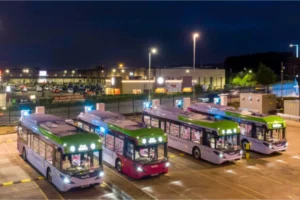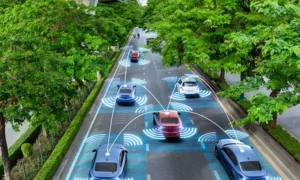By Kieran Corbally, Business Development Manager for MyCity, SWARCO Traffic
The rapid wheels of urbanisation have been in motion for a long time, and while the brakes were applied by events of the last 18 months, they carry a momentum that shows no signs of stopping. According to the UN, more than half of the world currently lives in urban areas, with this figure set to rise to 70% by 2050.[1]
The case of the UK is even more extreme, as more than 90% of the population lives in towns and cities. This translates into vast road usage across these urban sites. Vehicles on urban A roads, for example, covered 49.2 billion miles in 2019, and this figure was 83.2 billion for urban minor roads.[2] Not surprisingly, therefore, congestion is a constant challenge, with the average UK driver forced to spend a staggering 132 hours per year stuck in traffic.[3]
The primary task of city managers, in traffic terms, is naturally to reduce congestion and increase the efficiency of traffic management within the city. It is also about improving air quality and the environment. The Intergovernmental Panel on Climate Change’s (IPCC) report stated a ‘code red for humanity’ and carried the warning that greenhouse gas emissions must peak within four years to avoid irreversible damage to the environment.
The ramifications of the climate crisis are being felt at an international level, with President Joe Biden promising a ‘decisive decade’ for climate change, and the UK leading the United Nations Climate Change Conference (COP26) in November this year. Aside from a few notable examples, leaders across the world are integrating sustainability into central policy and campaign platforms, which of course is landing on the doorstep of local governments.
Harnessing data
So how should city planners address the coexisting issues that are being presented by rapid urbanisation and the subsequent congestion problems that follow? The truth, unfortunately, is that there is no single answer. No silver bullet. Route planning, congestion charge zones and encouraging the use of public transport are common approaches, though they rely on a series of separate sources of data and monitoring. Here lies a key issue faced by local governments: how best to manage the surplus of data relating to separate elements of a city’s traffic management system.
This is where SWARCO’s MyCity solution comes in. The platform unifies the various elements of traffic management in a single, easy to use system. Realising the need for a holistic solution, SWARCO decided in 2017 to bring the various elements of its software products together and combine them under one umbrella. To create a system that meets the needs of local authorities, more than 450 interviews were conducted with the relevant stakeholders, revealing several consistent preferences: automation, modularity and scalability.
Tasked with creating an automated, modular and scalable platform, MyCity combined SWARCO’s various traffic management solutions under one system.
Monitoring
MyCity provides monitoring to share, process and analyse data from different systems in an urban environment and act as an aggregator of mobility-relevant data sources. Moreover, the data can be collected in real time to respond to situations as and when they occur, or historical for insight to be used for long-term planning.
Similarly, an air quality monitoring option is available. Again, providing historic and real time data, levels of CO2 and N2O can be easily monitored to provide a clearer picture of where future investments are needed. With congestion charge zones become increasingly common, this tool provides the information needed to inform decisions on where congestion should be limited, as well as the impacts of a congestion charge following implementation.
This data is playing a key role in making cities cleaner and more accessible for cyclists, pedestrians, and users of public transport. The aforementioned push on climate change, as well as the fact that 49% of cities in high-income countries do not meet World Health Organization air quality guidelines, shows the need for such a solution.
These monitoring measures are vital to city managers. They give them the ability to respond to events and manage traffic flow in real time. But they are also useful for longer term projects relating to sustainability or scheduling. However, officials also need the ability to action changes, both in the long and short term, and for this MyCity provides a range of functions to address the wider traffic management ecosystem.
Traffic Control
MyCity includes a Traffic Management System (TMS) module. This enables operators to make proactive decisions to manage traffic through city roads, enhancing flow efficiency, the number of people choosing alternative forms of transport, as well as reducing congestion and travel times. An enhanced TMS system is also available for complex traffic systems where short-term flow forecasting, scenario selection and green time distribution updates are required, such as densely populated cities and those hosting large events.
Operators can also control Variable Message Signs (VMS) throughout the city, from either a mobile phone or desktop. A parking guidance module similarly allows the static or dynamic parking signs to be updated in seconds. It is thought that 30% of emissions caused by congestion stem from people on the hunt for a parking space,[4] which outlines the need for such measures to be integrated into a holistic traffic management system.
A Traffic Light Forecast function has also been designed to provide direct communication between SWARCO field devices and vehicle OEMs. This is SWARCO’s first solution in the field of Cooperative, Connected and Automated Mobility (CCAM), and is a function that is helping prepare citiesfor digitalisation, as car-to-car communications become normalised, and the Internet of Things really takes its hold.
This is a key element of MyCity, and a key factor that needs to be considered by traffic managers. Traffic systems must meet the many and varied demands of the present day, but they also need to be prepared for the digitised, automated world of tomorrow. Smartphones and smart watches have broken into the mainstream. Smart homes are with us too. And with the prospect of driverless cars on the horizon, it is crucial that traffic management systems get ahead of the developments, or they risk being left behind.
MyCity is a holistic traffic management system with all the tools and solutions city planners need in one simple piece of software. Its modularity allows flexibility depending on the requirements, size and budget of the city, as well as scalability for those operators looking to prepare for the future. And it does this without making a trade off with the environment. It puts the climate crisis at the front and centre of urban planning and provides the data required to make informed decisions to reduce emissions. It is, in short, a global solution built to solve local challenges.
[1] https://www.un.org/en/ecosoc/integration/pdf/fact_sheet.pdf
[2]https://assets.publishing.service.gov.uk/government/uploads/system/uploads/attachment_data/file/916749/road-traffic-estimates-in-great-britain-2019.pdf
[3] https://www.fuelgenie.co.uk/news/the-most-congested-uk-cities/
[4] https://www.parkingtoday.com/articledetails.php?id=2624&t=is-30-percent-of-traffic-cruising-for-parking#:~:text=%E2%80%9CResearchers%20found%20that%2030%20percent,by%20drivers%20cruising%20for%20parking.%E2%80%9D





















